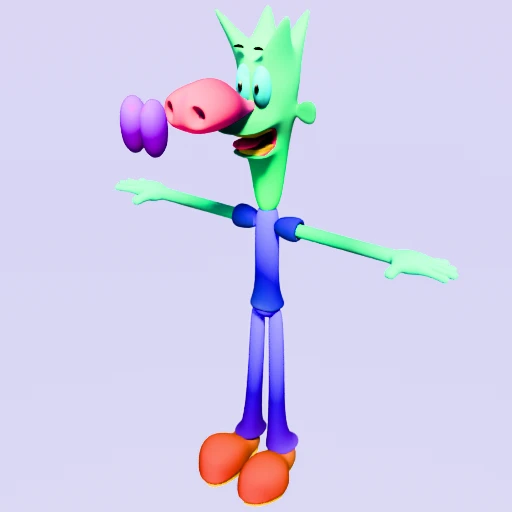So I've been experimenting more with the ultra-memory-efficient gradient map texturing technique I told you about a couple blog posts ago and found even the 64 x 64 map (singular, not plural) I used in This Recent Art Portal Submission for almost the entire scene (the Cityscape backdrop is of course a separate, much-large image) is a bit overkill. I've now found a way for my bright, cartoon-y artstyle to get away with an even smaller 16 x 16 pixel image map texturing everything:

Feel free to right-click > Save As the tiny image above if you want to try out gradient map texturing for yourself, which I'm sure you do if you want to participate in Newgrounds' first ever Low-Poly Art day. It's not copyrighted work or anything I would prefer you not steal.
Here's an updated version of my Gunk model (from Punk and Gunk) using the tiny 16 x 16 texture above:

As before, the trade-off is that with a single, almost excessively-low-res texture, I can more comfortably and efficiently use the slower-but-more-realistic Blender Cycles, as opposed to Eevee (though this technique still looks decent enough in real-time renderers and engines) and much higher poly counts in the final render, without having to wait AGES just for one frame of animation to render. It should be noted that other optimization techniques are necessary--for example, 4096 samples for a default Cycles render is WAY too high and slow, especially if you use the Denoiser, and even then, the default values for the Denoiser are set unnecessarily high for this rendering style by default.
All this experimentation from me as of late sort of brings up an interesting question: Why aren't more indie and AA games with similar un-textured, cartoon-y looks optimized this way? It's more understandable with AAA games with realistic graphics and much-more detailed textures, where it seems like 4K texture sizes and tile mapping (both EXTREMELY hard on a computer or console's GPU) seem to be the absolute minimum for avoiding the dreaded "blurry texture" on massive 4KTVs and monitors these days, and obviously this technique which only uses basic, un-textured colors is not even feasible for such art styles. But this technique has truly sped up even my Cycles renders and is generally much easier to work with on my aging laptop, to the point where I feel if more indie games with simple, colorful graphics would have comfortably run at 60 FPS even on the notoriously-dinky Switch 1 or laptops most people can actually afford.
Of course, it's not the only way, and I guess if you get REALLY into Blender and 3D, geeking out about all the many different ways you can optimize your textures while ensuring it still looks amazing where it counts is all part of the nerdy fun of texturing 3D models. Perhaps instead of this, you would prefer the more artist-friendly approach of just hand-painting textures, but not using bigger image sizes than you need for simple cartoony art styles. I personally find only 128 x 128 texture maps, or 256 x 256 images, are the bare minimum I can get away with and it certainly allows for more detail than 16x16 color gradient images and you wouldn't have to spend quite as much time modeling every separate part of your character like I do with the gradient map workflow, since you can just fake details with texture paints.
All in all, I hope the fun I have in figuring out cool and bizarre new techniques continues to show through somehow by ensuring you find my future animations and renders fun, as well!